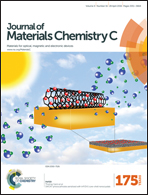High mobility transistors based on electrospray-printed small-molecule/polymer semiconducting blends†
Abstract
Spray-coating techniques have recently emerged as especially effective approaches for the deposition of small semiconducting molecules toward the fabrication of organic field-effect transistors (OFETs). Despite the promising mobility values and the industrial implementation capability of such techniques, the resultant devices still face challenges in terms of morphology control and performance variation. In this work, the efficient process control of electrostatic spraying deposition (ESD) and the excellent film forming properties of polymer:small molecule blends were successfully combined to develop reliable and high performance transistors. Specifically, a highly efficient blended system of 2,8-difluoro-5,11-bis(triethylsilylethynyl)-anthradithiophene (diF-TES-ADT) and poly(triarylamine) (PTAA) was employed in order to realize top-gate OFETs under ambient conditions, both on rigid and on flexible substrates. The films revealed extensive crystallization and microstructural organization implying distinct phase separation in the electrosprayed blend. Furthermore, we investigated the effect of processing temperature on film continuity and the presence of grain boundaries. Remarkably, the electrosprayed OFETs exhibited field-effect mobilities as high as 1.7 cm2 V−1 s−1 and enhanced performance consistency when compared to conventional gas-sprayed transistors. Additionally, the transistors showed excellent electrical and environmental stability, indicative of the good interface quality and the self-encapsulation capability of the top-gate structure. These results highlight the great potential of electrohydrodynamic atomization techniques for implementation in large-area processing for OFET fabrication.


 Please wait while we load your content...
Please wait while we load your content...